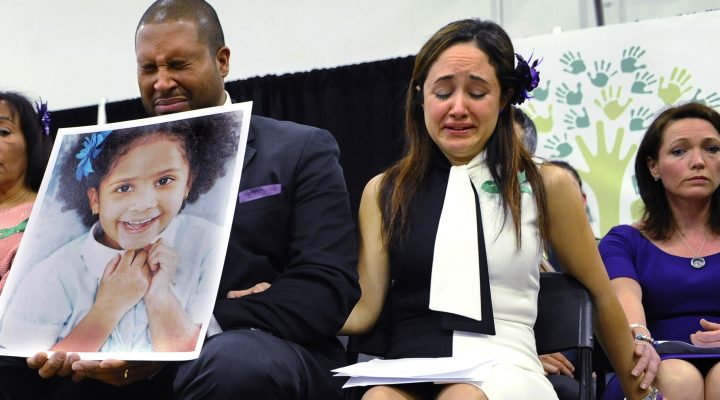It’s been 10 years since 20 first graders and six adults were killed during a tragic attack by a gunman at Sandy Hook Elementary School. News of the shooting shocked the nation. The event was one of the deadliest school shootings in the history of the United States, and families of its victims, as well as survivors, still feel the impacts of this traumatic experience.
Barack Obama, who was president at the time, still describes the event as the darkest day of his presidency.
President Joe Biden, who was vice president at the time, recently attended the National Vigil for All Victims of Gun Violence and before speaking was introduced by Sandy Hook survivor Jackie Hegarty, who is now a senior in high school.
His speech reflected on the tragedy and called for change. Although there have been improvements to gun safety laws during his administration, he says it is “still not enough,” calling again for a ban on assault weapons to prevent such violence from repeating.
An array of survivors from other school shootings also are speaking out about the issue, including Taylor Schumann, whose 2021 book When Thoughts and Prayers Aren’t Enough tells readers about her experience surviving and recovering after being shot at school, as well as her perspective on what America should do moving forward.
She challenges readers to not get lost in the numbers and statistics necessary to talk about gun violence: “I’d like to ask you to never forget that every number represents a person, someone just like you and me. If gun violence isn’t already personal to you, then make it personal.”
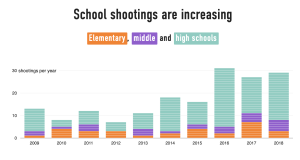
Graphic: CNN
When, where and how often school shootings occur
Despite protests, social media campaigns and responses by politicians, in the past 10 years, there have been 180 school shootings in America, claiming 356 victims — 114 killed and 242 injured, sometimes severely.
In the past year alone, there have been 47 school shootings in the United States that resulted in injuries or death. This is the largest number of school shootings per year in the country since 2018.
The data show race plays a key role in what time shootings are likely to occur, and who are likely to be victims.
One-third of students who have experienced a school shooting are Black, a disproportionate share compared to the overall portion of Black students in America. Shootings at predominantly Black schools are likely to occur during after-school events, such as sporting events when students are congregated at the school outside of class times.
In contrast, shootings at predominantly white schools are more likely to begin during the school day, either in the morning when classes begin, or during dismissal time. These shootings generate the most casualties compared to other demographics.
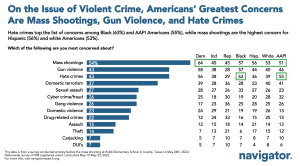
American attitudes
Since the tragic attack at Sandy Hook in 2012, American attitudes surrounding gun violence and school shootings have become the center of attention for political and social justice conversations.
According to a Navigator Research Poll conducted earlier this year, seven out of 10 Americans think gun violence and mass shootings are a crisis or major issue society should be addressing.
There is a slight divide when the poll’s participants are broken up by political affiliation and race, with Democrats being more likely to think these issues are a crisis or major issue than Republicans. Black people are also more likely than other races to hold this same view.
However, there is no demographic category in which even half of poll participants believe these are not major issues. In every group polled, the majority agrees these are crises or major issues. In fact, even about 60% of gun owners agreed these are very serious issues.
Attitudes right after Sandy Hook
Gallup published three studies in the months following the shooting at Sandy Hook. The first poll, published days after the attack, focused on American views surrounding the police and mental health initiatives as solutions to gun violence at schools.
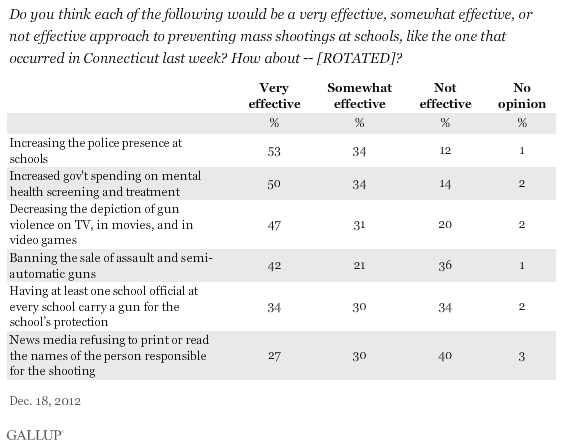 According to that poll, most Americans in December 2012 believed increasing the presence of police at schools and increasing the amount of government spending on mental health screening and treatment would be very effective (53% and 50%) at preventing mass shootings in elementary schools, such as the one that occurred at Sandy Hook.
According to that poll, most Americans in December 2012 believed increasing the presence of police at schools and increasing the amount of government spending on mental health screening and treatment would be very effective (53% and 50%) at preventing mass shootings in elementary schools, such as the one that occurred at Sandy Hook.
That poll also found slightly less than a majority (47%) believed decreasing media and video game gun violence children are exposed to would be very effective.
When segregated by political affiliation and asked about different approaches to preventing these same attacks, both Republicans (55%) and Democrats (52%) believed increasing police presence in schools would be very effective. The parties were more divided on other approaches, though:
- 67% of Democrats believed increased government spending on mental health screening and treatment would be very effective, in comparison to only 35% of Republicans.
- 61% of Democrats believed a ban on the sale of assault and semi-automatic guns would be very effective, while only 26% of Republicans agreed.
- Just under a majority of Republicans (49%) believed allowing at least one school official (such as a teacher or administrator) to carry a gun would be very effective, compared to 27% of Democrats.
Gallup concluded that the bottom line to these findings was, “Americans don’t hold the belief that any one action would be overwhelmingly effective in preventing future mass shootings at schools.” Although it was clear Americans across the board felt strongly about the issue of K-12 shootings after the violence at Sandy Hook, it seems nobody agreed on a solution.
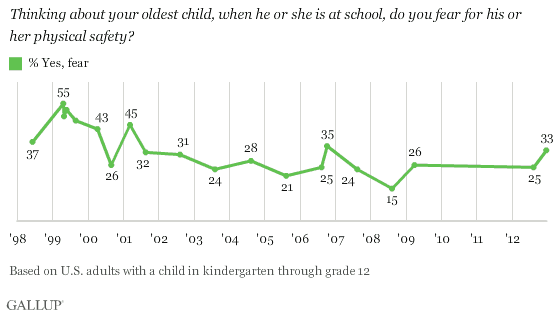
The second poll, published two weeks after the attack, highlighted the slight rise in fear parents felt for their children’s safety at school.
The poll found that after the shooting, parents were “slightly more concerned about their children’s safety at school than they were in August,” with 33% of parents being fearful for the safety of their oldest child.
Gallup also reported 52% of Americans believed it was very or somewhat likely that a similar event could occur in their own community. Broken down into demographics:
- Women (60%) were much more likely than men (43%) to agree with this statement, white respondents (54%) were slightly more likely to agree than nonwhite respondents (47%), and older respondents were the most likely to agree compared to other age groups.
- Additionally, and perhaps most surprisingly, respondents who did not have children in K-12 schools were more likely to agree with this statement than people who did have children in K-12 schools.
- 56% of parents believed the school their oldest child attended was “doing enough” to prevent a shooting similar to the one that occurred at Sandy Hook.
For this survey, Gallup noted the increase in concerned feelings among parents and Americans was not substantially higher than at the beginning of the 2012 school year and that there was not a high surge in concern after the Sandy Hook shooting, which is typically expected after such tragedies. Researchers are unsure why, explaining this difference may have been a result of increased security measures or even desensitization to such events.
The final poll, published just over a month after the attack, addressed American support for Obama’s proposals to address gun violence. Researchers found for all nine proposals in the former president’s plan to reduce gun violence, a majority of Americans expressed support.
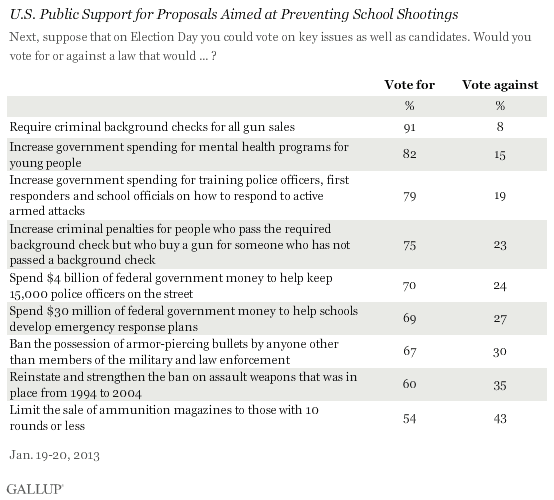 Americans were the most supportive of his proposal to require criminal background checks prior to all gun sales, with 91% of Americans saying they would vote positively if given the chance. In contrast, Americans were the least supportive of a limitation on the sale of ammunition magazines, with 54% saying they would vote positively.
Americans were the most supportive of his proposal to require criminal background checks prior to all gun sales, with 91% of Americans saying they would vote positively if given the chance. In contrast, Americans were the least supportive of a limitation on the sale of ammunition magazines, with 54% saying they would vote positively.
The same levels of support were found when researchers looked at political affiliation and response. For almost all nine of Obama’s proposals, Democrats, Republicans and independents said they would vote positively if given the chance.
The only two proposals that did not reach a majority were the re-institution of a stronger assault rifle ban, for which 49% of Republicans would have voted positively, and the ban on magazines, for which 39% of Republicans and 46% of independents would have voted positively.
Current attitudes
Gallup also has come out with new data to compare current attitudes surrounding school shootings with attitudes immediately after the Sandy Hook attack.
Researchers found that after three high-profile mass shootings at K-12 schools (Sandy Hook Elementary School in 2012, Marjory Stoneman Douglas High School in 2018, and Robb Elementary this year) there was an increase in Americans’ calls for stricter gun laws, consistently followed by a decline in support for these tighter restrictions.
Researchers also measured parental fear for their children’s physical safety at school.
After the Sandy Hook school shooting, fear increased, then remained at the same level for several years, finally decreasing to the level it was before the incident by 2017. After the shooting at Marjory Stoneman Douglas, fear spiked once again, then remained at the same rate for the following year. This year, in response to the shooting at Robb Elementary, fear increased by 10 percentage points, the highest it has been in a decade.

Pew Research Center’s recent survey corroborates findings from the Gallup polls, looking further into factors such as gender, ethnicity, political affiliation and income level as they are correlated with attitudes toward school shootings.
Pew researchers found 32% of parents of children in K-12 schools report feeling very or extremely worried about a shooting happening at their children’s school. Another third, 37%, feel somewhat worried about this. The survey was conducted after this year’s shooting at Robb Elementary School.
Sentiments of concern differ when split up by gender, ethnicity and income. Mothers (39%) are much more likely to say they are extremely or very worried compared to fathers (24%). Hispanic adults are more likely than any other ethnicity to feel the same way, and lower-income adults are the most likely to feel this way compared to adults with higher incomes.
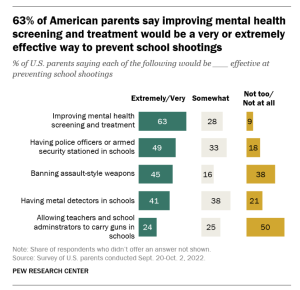 When asked about ways to prevent school shootings in America, 63% of American parents say improving mental health screening and treatment would be a very or extremely effective method. Just under a majority (49%) of Americans believe having police officers or armed security in schools would be helpful.
When asked about ways to prevent school shootings in America, 63% of American parents say improving mental health screening and treatment would be a very or extremely effective method. Just under a majority (49%) of Americans believe having police officers or armed security in schools would be helpful.
When asked about allowing teachers or school administrators to carry guns at school, 50% of American parents said this would not be too effective or not effective at all.
Thoughts on solutions did, however, differ by political affiliation. More Democrats were in favor of improving mental health screening and treatment (70%), as well as banning assault-style weapons (67%). In contrast, more Republicans were in favor of having police officers or armed security in schools (61%) and allowing teachers or administrators to carry guns at school (41%).
So, 10 years after the massacre at Sandy Hook, a good chunk of American parents still fear their children may fall victim to gun violence at school, but as the violence continues, there are differing opinions on what to do about this pressing issue.
Sandy Hook Promise
But what has been done?
An organization called Sandy Hook Promise, founded by the parents and relatives of Sandy Hook victims, continues to fight for change.
In addition to sharing the stories of survivors, Sandy Hook Promise has four programs that aim to educate children and teens on important social and institutional factors that may contribute to gun violence and offer communities of support.
For children K-12, the program Start with Hello teaches children how to be connected with other students at school in an effort to prevent the social isolation that can lead students to committing these acts of violence.
Say Something is a program offered for two different age groups, one for grades four through 12, and another for grades six through 12. The program helps students learn the warning signs and threats commonly said (or posted online) by someone who may hurt themselves or others. For the program aimed at grades four through 12, students learn how to reach out to trusted adults if they feel something is not right. For the program aimed at grades six through 12, students have access to an anonymous reporting system that can be downloaded on their phones.
Additionally, the organization provides the SAVE (Students Against Violence Everywhere) Promise Club to student groups. These clubs are student-led, and the organization provides resources for “events, activities and projects that promote kindness, inclusiveness and the value of looking out for one another.”
Remembering the names
One of the keys to change, of course, is not forgetting what has happened and what could happen again.
For this week’s anniversary, Business Insider recently published a list of victims, as well as photos and descriptions to memorialize the tragedy.
All the children who were murdered at Sandy Hook were between the ages of 6 and 7, so they would be 16 or 17 years old today.
The teachers and staff were Victoria Soto (27), Lauren Rousseau (30), Dawn Hochsprung (47), Mary Sherlach (56), Rachel Davino (29) and Anne Marie Murphy (52). The gunman also killed Nancy Lanza (52), his mother, before going to the school to commit the shooting.
Mallory Challis is a senior at Wingate University and currently serves as BNG’s Clemons Fellow.
Related articles:
Reflections on the 10th anniversary of Sandy Hook | Opinion by Paul Hayes
‘Once America decided killing children was bearable, it was over’ | Opinion by Kathy Manis Findley
Yes, there is a way out of our national gun violence epidemic | Analysis by Paul Robertson
Murders at Club Q open debate on American gun violence once again | Analysis by Mallory Challis
In the gun violence debate, let’s stop scapegoating mental illness | Opinion by Curtis Ramsey-Lucas

